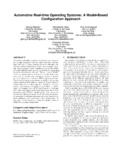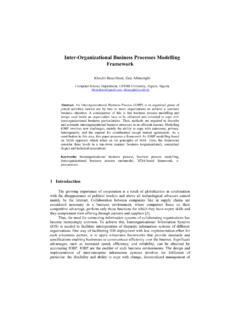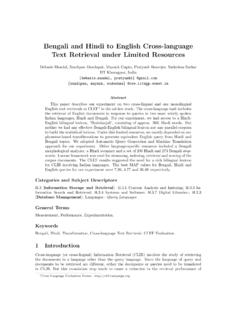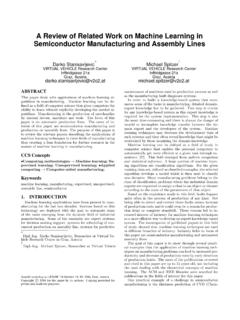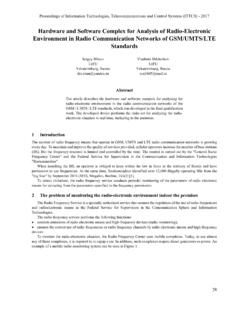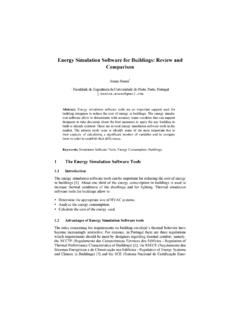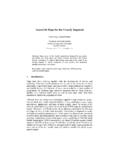Transcription of Software Risk Management: Using the Automated …
1 Software Risk management : Using the Automated Tools Sergey M. Avdoshin, Elena Y. Pesotskaya School of Software Engineering, Software management Department, National Research University Higher School of Economics, Moscow, Russian Federation. {Savdoshin, Abstract. Software development process nowadays faces many challenges and risks . In order to manage risks we need to understand the scope and objectives of the Software developments and use the appropriate Automated risk management tool. The study addresses Software risk management in Software development area and an approach to analysis, structuring, and evaluating risk with the help of specialized Automated tools.}
2 The author provides recommendations on how to define a set of selection criteria for Automated tools and analyses the growing demand for service hosting solutions and web-applications, stressing that almost any Software including risk management tools can be successfully run Using this method. Keywords: Software risks , risk management , risk management Software , risk management tools, web-based applications, SaaS solution. 1 Introduction There are many risks involved in creating high quality Software that need to be carefully managed. Despite new technology, innovative methods and tools, different management methods - development process still full of risks from the beginning to the end.
3 Therefore, to make sure a project successful we require managing specific IT risks related to our Software projects: identify risks and store in a shared data storage, assess risks , Using specialized tools and techniques, choose appropriate mitigation action and track that mitigated risks are lower when they were. The need for project risk management has been widely recognized by all Software development companies such as Microsoft, SAP, Oracle, IBM etc. Being a development companies they usually use their own powerful Automated tools to minimize losses and maximize Software development success.
4 As the purpose of project risk management is to improve project performance by systematically identifying and assessing risks , developing strategies to reduce or avoid risks , and maximizing opportunities [2], risk management tools should support a continuous risk management process throughout the life cycle of a system. Effective risk management depends on risk management planning; early identification and analyses of risks ; early implementation of corrective actions; continuous monitoring and reassessment; communication, documentation, and coordination. The science of risk management was developed back in the sixteenth century during the Renaissance, a period of discovery, but regarding the subject of Risk management Process (RMP), since 1990 a large number of methodologies and methods have been generated to address the need for more effective risk management [7].
5 Among them we can distinguish the PUMA [5] and the MRMP [8] in construction engineering context; the RFRM [6] in system engineering context; the SHAMPU [2] and the PMBoK [9] in project management context; the standard of the AS/NZS 4360 [4] and the DoD [3] in public application context, etc. In the present paper, we have investigated and compared most of risk related topics in Software engineering context and Automated tools that support risk management process. Risk management should begin at the earliest stages of program planning and continue throughout the total life-cycle of the program.
6 Additionally, risk management is most effective if it is supported with Automated tool that ensures integration with the program's systems engineering and program management processes. Common practices, concerning risk management is to identify and track issues and risks and then manage the root causes or the consequences (if we were not successful while managing root causes). But also the objective of a proper risk management tools is to provide a repeatable process for balancing cost, schedule, and performance goals within program funding, especially on programs with designs that approach or exceed the state-of-the-art or have tightly constrained or optimistic cost, schedule, and performance goals.
7 Successful risk management depends on the knowledge gleaned from assessments of all aspects of the program coupled with appropriate mitigations applied to the specific root causes and consequences. Software risk management is not a stand-alone task. It is supported by a number of other tasks as the results of risk management are used to finalize requirements development, logical solution, systems engineering, cost estimating, schedule development, performance measurement, etc. Process and tools for Software risk management In Software development process, risk management concerns all aspects of the program life cycle phases as they relate to each other, from initiation to disposal.
8 There are basic risks that are generic to almost all Software projects. In reality many IT projects are very similar at a high, strategic level. They differ in people involved and exact events. An effective risk management process requires a commitment on the part of the project manager, the project team, and the contractor to be successful. The project team and management should establish a risk management process that includes not only risk planning, but also risk identification, risk analysis, risk mitigation planning, risk mitigation plan implementation, and risk tracking to be integrated and continuously applied throughout the whole program.
9 For that purposed some Automated risk management tools provide seamless integration with Microsoft Project to quantify the cost and schedule uncertainty associated with project plans. Other tools have possibilities of integration with Microsoft Excel and illustrate many possible outcomes, cost and schedule histograms in your Microsoft Excel spreadsheet. In the planning phase, the goal of successful risk management is to adapt risk management to the organization s existing project and risk management practices and to document the resulting processes in a risk management plan.
10 Any computerized tools, databases or forms are installed. Project personnel is being trained both in the processes to be carried out and in the methods and tools to use. Finally the risk management activities must be started and become habitual routine within the project. Also before we start the Software risk management , several questions should be answered: What do we expect from risk management ? Who would participate, how often? What skills, competencies are required for risk management ? What are the main risk management steps and deliverables? What actions would be conducted on each step?
